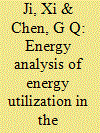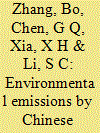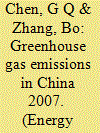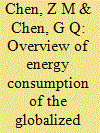|
|
|
Sort Order |
|
|
|
Items / Page
|
|
|
|
|
|
|
| Srl | Item |
| 1 |
ID:
104972


|
|
|
|
|
| Publication |
2011.
|
| Summary/Abstract |
Presented in this study is an empirical analysis of embodied carbon dioxide emissions induced by fossil fuel combustion for the world divided into three supra-national coalitions, i.e., G7, BRIC, and the rest of the world (ROW), via the application of a multi-region input-output modeling for 2004. Embodied emission intensities for the three coalitions are calculated and compared, with market exchange rate and purchase power parity separately used to investigate the difference between nominal and real production efficiencies. Emissions embodied in different economic activities such as production, consumption, import, and export are calculated and analyzed accordingly, and remarkable carbon trade imbalances associated with G7 (surplus of 1.53 billion tons, or 36% its traded emissions) and BRIC (deficit of 1.37 billion tons, or 51% its traded emissions) and approximate balance with ROW (deficit of 0.16 billion tons, or 3% its traded emissions) are concretely revealed. Carbon leakages associated with industry transfer and international trades are illustrated in terms of impacts on global climate policies. The last but not least, per capita consumption based emissions for G7, BRIC, and ROW are determined as 12.95, 1.53, and 2.22 tons, respectively, and flexible abatement policies as well as equity on per capita entitlement are discussed.
|
|
|
|
|
|
|
|
|
|
|
|
|
|
|
|
| 2 |
ID:
125469


|
|
|
|
|
| Publication |
2013.
|
| Summary/Abstract |
Comprehensive inventory of cities' greenhouse gas emissions (GHG) is the basis for cities to make appropriate mitigation plans. However, previous studies on cities' GHG emissions consider emissions occurring within the city boundary (Scope 1) and out of boundary electricity emissions (Scope 2), but neglect indirect emissions associated with commodities consumed by cities (Scope 3), resulting in emission leakage. To cope with this problem, a systematic accounting covering all 3 scopes is presented in a case study of Macao for the years 2005-2009, based on the latest embodied emission intensity databases for China and for the world. The results show that total emissions are dominated by indirect emissions mainly embodied in imports, which is 3-4 times direct emissions during the period concerned. It is verified that accounting under Scopes 1 and 2 cannot capture the full picture of cities' emissions, especially cities like Macao which are dominated by service industry and inevitably sustained by massive materials and services from other regions. Our study suggests that Macao should adjust its current GHG mitigation policies which consider only its emissions occurring within its border, as Macao is a net GHG emissions importer. This work is the first assessment of Macao's embodied GHG emissions.
|
|
|
|
|
|
|
|
|
|
|
|
|
|
|
|
| 3 |
ID:
113456


|
|
|
|
|
| Publication |
2012.
|
| Summary/Abstract |
For Chinese industry, the costs of different energy consumption abatement scenarios are evaluated by the method of directional distance function. These scenarios are based on the combinations of regulation strategies and allocation alternatives-the former are sectors and provinces, and the latter include the five principles of average, intensity share, absolute share, discriminatory absolute and discriminatory intensity. For all the scenarios, the quantitative impacts in terms of output potential loss are calculated and compared. Due to less output potential loss for all the allocation alternatives, the sector regulation strategy is shown to be more effective than the province regulation strategy. It is also demonstrated that, among all the scenarios considered, the sector regulation based on the intensity share principle and the province regulation based on the absolute share principle are the two optimal. The performances of energy abatement allocation of the 11th and 12th Five Year Plans of China are assessed against the simulated scenarios.
|
|
|
|
|
|
|
|
|
|
|
|
|
|
|
|
| 4 |
ID:
069809


|
|
|
| 5 |
ID:
105770


|
|
|
|
|
| Publication |
2011.
|
| Summary/Abstract |
For the Chinese industry as the mainstay of the national economy and dominant energy user and carbon emitter, an integrative assessment is performed from major energy policy perspectives of energy security, energy efficiency and carbon emission. Extensive systems indicators, including oil dependence ratio, average oil growth rate; indices of energy diversity, of carbonization and of oil growth risk; ratios of energy use to output, to value added and to compensation for laborers; ratios of carbon emission to output, to value added and to compensation for laborers, are devised to assess the Chinese industry 2002-2007 with most recent statistics availability. Combined indicators are identified by sparse principle component analysis to characterize sector performances. The industrial sectors are classified into five clusters and the main features of each cluster are pinpointed using fuzzy clustering algorithm. Concrete results facilitate comparisons of sectors to enable more accurate policy recommendations.
|
|
|
|
|
|
|
|
|
|
|
|
|
|
|
|
| 6 |
ID:
113460


|
|
|
|
|
| Publication |
2012.
|
| Summary/Abstract |
Based on chemical exergy as an objective measure for the chemical deviation between the emission and the environment, a unifying assessment is carried out for major environmental emissions covering COD, ammonia nitrogen, SO2, soot, dust, NOx and solid waste by Chinese industry over 1997-2006, with emphasis on the sectoral and regional levels in 2006. Of the total emission in exergy up to 274.1 PJ in 2006, 67.7% is estimated from waste gases, 29.9% from waste water and 2.4% from solid waste. Five of 40 sectors and 12 of 30 regions are responsible for 72.7% and 65.5% of the total emission, respectively. SO2 is the leading emission type in 9 sectors and 25 regions, and COD in another 28 sectors and 5 regions. Some pollution-intensive sectors such as Production and Distribution of Electric Power and Heat Power and Manufacture of Paper and Paper Products, and western and inland regions such as Guangxi and Ningxia with high emission intensities are identified. By clustering and disjoint principal component analysis with intensities of emissions and fuel coal use as variables, three principal components are extracted, and four statistically significant clusters are pinpointed in the sectoral and regional analysis. Corresponding policy-making implications are addressed.
|
|
|
|
|
|
|
|
|
|
|
|
|
|
|
|
| 7 |
ID:
098692


|
|
|
|
|
| Publication |
2010.
|
| Summary/Abstract |
For greenhouse gas (GHG) emissions by the Chinese economy in 2007 with the most recent statistics availability, a concrete inventory covering CO2, CH4, and N2O is composed and associated with an input-output analysis to reveal the emission embodiment in final consumption and international trade. The estimated total direct GHG emission amounts to 7456.12 Mt CO2-eq by the commonly referred IPCC global warming potentials, with 63.39% from energy-related CO2, 22.31% from non-energy-related CO2, 11.15% from CH4 and 3.15% from N2O. Responsible for 81.32% of the total GHG emissions are the five sectors of the Electric Power/Steam and Hot Water Production and Supply, Smelting and Pressing of Ferrous and Nonferrous Metals, Nonmetal Mineral Products, Agriculture, and Coal Mining and Dressing, with distinctive emission structures. The sector of Construction holds the top GHG emissions embodied in both domestic production and consumption, and the emission embodied in gross capital formation is prominently more than those in other components of the final consumption characterized by extensive investment in contrast to limited household consumption. China is a net exporter of embodied GHG emissions, with emissions embodied in exports of 3060.18 Mt CO2-eq, in magnitude up to 41.04% of the total direct emission.
|
|
|
|
|
|
|
|
|
|
|
|
|
|
|
|
| 8 |
ID:
111341


|
|
|
|
|
| Publication |
2012.
|
| Summary/Abstract |
Nonrenewable energy cost is accounted for the believed renewable biofuel of corn-ethanol in China. By a process-based energy analysis, nonrenewable energy cost in the corn-ethanol production process incorporating agricultural crop production, industrial conversion and wastewater treatment is conservatively estimated as 1.70 times that of the ethanol energy produced, corresponding to a negative energy return in contrast to the positive ones previously reported. Nonrenewable energy cost associated with wastewater treatment usually ignored in previous researches is shown important in the energy balance. Denoting the heavy nonrenewability of the produced corn-ethanol, the calculated nonrenewable energy cost would rise to 3.64 folds when part of the nonrenewable energy cost associated with water consumption, transportation and environmental remediation is included. Due to the coal dominated nonrenewable energy structure in China, corn-ethanol processes in China are mostly a conversion of coal to ethanol. Validations and discussions are also presented to reveal policy implications against corn based ethanol as an alternative energy in long term energy security planning.
|
|
|
|
|
|
|
|
|
|
|
|
|
|
|
|
| 9 |
ID:
109622


|
|
|
|
|
| Publication |
2011.
|
| Summary/Abstract |
For the globalized world economy with intensive international trade, an overview of energy consumption is presented by an embodied energy analysis to track both direct and indirect energy uses based on a systems input-output simulation. In 2004, the total amounts of energy embodied in household consumption, government consumption, and investment are 7749, 874, and 2009 Mtoe (million tons of oil equivalent), respectively. The United States is shown as the world's biggest embodied energy importer (683 Mtoe) and embodied energy surplus receiver (290 Mtoe), in contrast to China as the biggest exporter (662 Mtoe) and deficit receiver (274 Mtoe). Energy embodied in consumption per capita varies from 0.05 (Uganda) to 19.54 toe (Rest of North America). Based on a forecast for 2005-2035, China is to replace the United States as the world's leading embodied energy consumer in 2027, when its per capita energy consumption will be one quarter of that of the United States.
|
|
|
|
|
|
|
|
|
|
|
|
|
|
|
|
|
|
|
|
|